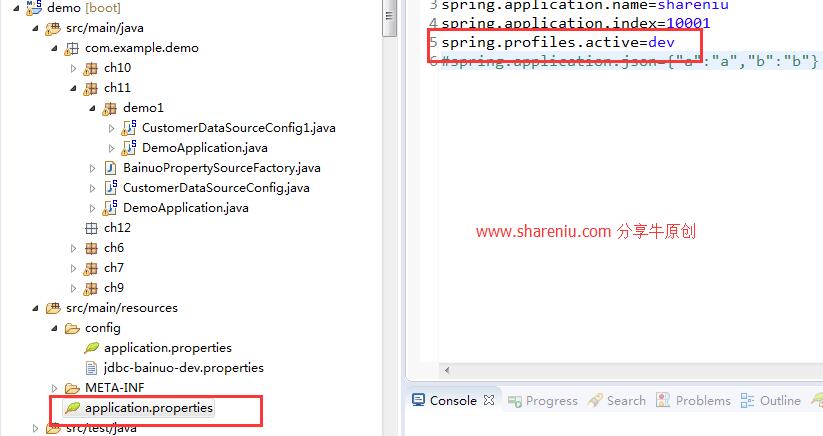springboot源码分析14-ApplicationContextInitializer原理Springboot中PropertySource注解多环境支持
Springboot中PropertySource注解的使用 一文中,详细讲解了 PropertySource注解的使用,通过PropertySource注解去加载指定的资源文件、然后将加载的属性注入到指定的配置类,@value以及@ConfigurationProperties的使用。但是也遗留一个问题,PropertySource注解貌似是不支持多种环境的动态切换?这个问题该如何解决呢?我们需要从源码中看看他到底是否支持。
首先,我们开始回顾一下上节课说的 PropertySource注解的使用,实例代码如下:
1 @PropertySource( name="jdbc-bainuo-dev.properties",
2 value={"classpath:config/jdbc-bainuo-dev.properties"},ignoreResourceNotFound=false,encoding="UTF-8")
我们使用了 PropertySource注解中的参数有:name、value、ignoreResourceNotFound、encoding。其实PropertySource注解还有一个参数,那就是factory,该参数默认的值为PropertySourceFactory.class。
PropertySource注解的定义如下:
1 public @interface PropertySource {
2 String name() default "";
3 String[] value();
4 boolean ignoreResourceNotFound() default false;
5 String encoding() default "";
6 Class<? extends PropertySourceFactory> factory() default PropertySourceFactory.class;
7 }
我们不妨先看一下 PropertySourceFactory接口是做什么的?该接口的核心定义代码如下:
1 public interface PropertySourceFactory {
2 PropertySource<?> createPropertySource(@Nullable String name, EncodedResource resource) throws IOException;
3 }
上述代码中, PropertySourceFactory接口仅仅提供了一个createPropertySource方法,该方法就是创建PropertySource实例对象的,关于PropertySource的架构可以参考前面的系列文章进行学习,既然是接口,那肯定有实现类吧?该接口的默认实现类为DefaultPropertySourceFactory,代码如下:
1 public class DefaultPropertySourceFactory implements PropertySourceFactory {
2 public PropertySource<?> createPropertySource(@Nullable String name, EncodedResource resource) throws IOException {
3 return (name != null ? new ResourcePropertySource(name, resource) : new ResourcePropertySource(resource));
5 }
首先判断 name参数值是否为空,如果不为空直接实例化ResourcePropertySource并将name参数值进行传递,否则直接实例化ResourcePropertySource。看到这个地方的处理,感觉也没什么神奇的地方,那么问题来了,我们思考如下三个问题:DefaultPropertySourceFactory 类什么时候被Spring框架调用呢?Name参数值是如何传递过来的呢?ResourcePropertySource实例化的时候做了什么呢?我们一个个的来看源码进行分析。
1.1. DefaultPropertySourceFactory 类什么时候被 Spring 框架调用呢
第一个问题: DefaultPropertySourceFactory 类什么时候被Spring框架调用呢?这个我们就需要看一下我们定义的PropertySource注解是如何被Spring框架解析的?经过我的一系列排查,我找到了。S pring框架开始解析PropertySource注解的方法位于ConfigurationClassParser类中,为了防止大量的跟踪源码跟踪丢失了,自己也糊涂了。我们直奔主题,看一下processPropertySource方法,如下所示:
1 private static final PropertySourceFactory DEFAULT_PROPERTY_SOURCE_FACTORY = new DefaultPropertySourceFactory();
2 private void processPropertySource(AnnotationAttributes propertySource) throws IOException {
3 String name = propertySource.getString("name");
4 if (!StringUtils.hasLength(name)) {
5 name = null;
7 String encoding = propertySource.getString("encoding");
8 if (!StringUtils.hasLength(encoding)) {
9 encoding = null;
11 String[] locations = propertySource.getStringArray("value");
12boolean ignoreResourceNotFound = propertySource.getBoolean("ignoreResourceNotFound");
13 Class factoryClass = propertySource.getClass("factory");
14 PropertySourceFactory factory = (factoryClass == PropertySourceFactory.class ?
15 DEFAULT_PROPERTY_SOURCE_FACTORY : BeanUtils.instantiateClass(factoryClass));
16 for (String location : locations) {
17 try {
18 String resolvedLocation = this.environment.resolveRequiredPlaceholders(location);
19 Resource resource = this.resourceLoader.getResource(resolvedLocation);
20 addPropertySource(factory.createPropertySource(name, new EncodedResource(resource, encoding)));
22 catch (IllegalArgumentException ex) {
23 if (ignoreResourceNotFound) {
24 if (logger.isInfoEnabled()) {
25 logger.info("Properties location [" + location + "] not resolvable: " + ex.getMessage());
28 else {
29 throw ex;
30 }
32 catch (IOException ex) {
上述代码的逻辑分为如下几个核心的步骤:
1. 开始解析 name 、 encoding值。
2. 解析value(数组)以及ignoreResourceNotFound值。
3. 解析factory,如果该值没有配置,默认为PropertySourceFactory则直接实例化DefaultPropertySourceFactory类,否则开始实例化自定义的类。换言之factory的处理类我们是可以进行自定义的。BeanUtils.instantiateClass是Spring 中比较常用的一个工具类,其内部就是通过反射手段实例化类,在这里我们就不一一讲解了。
4. 循环遍历所有的 location 值,进行如下的处理。
4.1. 对 location 进行 SPEL 表达式的解析。比如当前的配置环境中有一个属性为 app=shareniu ,我们配置的 location 为 ${app} 最终值为 shareniu 。通过这里的处理逻辑可以知道 location 支持多环境的切换以及表达式的配置。
4.2. 使用资源加载器 resourceLoader将resolvedLocation抽象为Resource。
4.3. 调用 addPropertySource属性进行处理。将指定的资源处理之后,添加到当前springboot 运行的环境中,这个前面的章节也详细讲解过类似的,在这里就不详细说明了。注意:这里调用了 DefaultPropertySourceFactory类中的createPropertySource方法了。
5. 如果上述的任意步骤报错,则开始查找 ignoreResourceNotFound的值,如果该值为treu ,则忽略异常,否则直接报错。在这里我们可以看出 ignoreResourceNotFound参数值的配置非常的重要。
1.2. ResourcePropertySource
我们看一下 ResourcePropertySource类的构造函数,主要看一下没有name参数的构造函数,如下所示:
1 public ResourcePropertySource(EncodedResource resource) throws IOException {
2 super(getNameForResource(resource.getResource()),PropertiesLoaderUtils.loadProperties(resource));
3 this.resourceName = null;
4 }
上述代码,我们重点关注一下 name值的生成逻辑。也就是 getNameForResource中的处理逻辑,如下所示:
1 private static String getNameForResource(Resource resource) {
2 String name = resource.getDescription();
3 if (!StringUtils.hasText(name)) {
4 name = resource.getClass().getSimpleName() + "@" + System.identityHashCode(resource);
6 return name;
7 }
通过resource中的getDescription方法获取name 值。如果 name 值为空,则重新生成,否则直接返回。大家又兴起可以看看 resource中各个子类的定义以及使用。
PropertiesLoaderUtils.loadProperties(resource)毋庸置疑就是加载指定的属性文件了。
1.3. PropertySource 多环境配置以及表达式使用
在 springboot中,可以通过设置spring.profiles.active属性,达到不同环境配置文件的动态切换。我们看一下这种方式如何使用,首先在application.properties增加如下的信息:
spring.profiles.active=dev
application.properties文件位置如下图所示:

然后,我们修改 CustomerDataSourceConfig1类,这个类的配置以及启动类进行测试可以参考上一篇文章进行学习。
1 @PropertySource( name="jdbc-bainuo-dev.properties",value= {"classpath:config/jdbc-bainuo-${spring.profiles.active}.properties"},ignoreResourceNotFound=false,encoding="UTF-8")
2 public class CustomerDataSourceConfig1 {
3 }
这里注意 value的值已经修改为了:"classpath:config/jdbc-bainuo-${spring.profiles.active}.properties"。
${spring.profiles.active}表达式可以动态的进行配置,从而达到动态切换不同的配置文件了。
欢迎关注我的微信公众号,第一时间获得博客更新提醒,以及更多 成体系 的Java相关原创技术干货。
扫一扫下方二维码或者长按识别二维码,即可关注。












![[HBLOG]公众号](http://www.liuhaihua.cn/img/qrcode_gzh.jpg)

